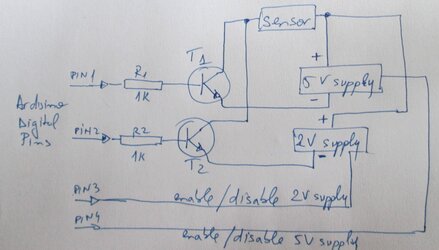
I have a sensor that needs in order to function 30 seconds 2V, 30 seconds 5V (on both max 300mA). I have done the power supplies, I can do the programming for the delay but I'm not sure exactly how to switch between them using some types of transistors. Can anyone help?
What I need is a kind of switch that on digital LOW goes on the 2V supply, and on HIGH goes to the 5V supply. What transistors should I use so they can be controlled from a digital PIN from Arduino and handle the max. 300mA current the sensor needs?
Please see the image for my idea (I'm a totally noob in electronics). Both supplies are done with MAX603/4 so they have an OFF switch. T1/T2 are 2N2222(see datasheet here) and I was thinking that I can disable one supply then enable the other one and so on. Will this work? If yes by just disabling/enabling the supplies .. maybe Pin1/Pin2 are useless. What do you think?
Thank you!
